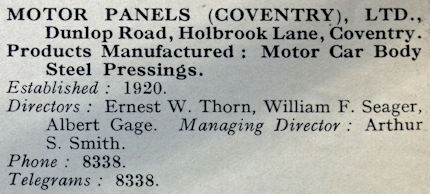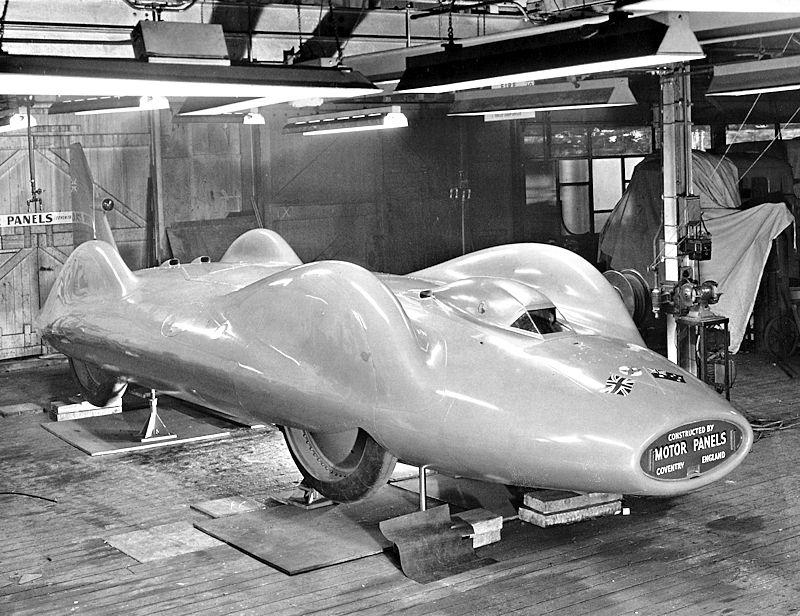|
Index...
|
 've always enjoyed tracing the founders of Coventry firms, and in many cases, the more difficult the people are to find then the more satisfying it becomes when you eventually get them. On this occasion, I give you the once well-known Coventry motor supply firm Motor Panels, largely based behind Burnaby Road and fronting Holbrook Lane for the most part of their existence.
've always enjoyed tracing the founders of Coventry firms, and in many cases, the more difficult the people are to find then the more satisfying it becomes when you eventually get them. On this occasion, I give you the once well-known Coventry motor supply firm Motor Panels, largely based behind Burnaby Road and fronting Holbrook Lane for the most part of their existence.

The company began in a small way as Panels (Coventry) Ltd in 1920 at redundant bakery buildings at George Street, once used by Climax Motors Ltd from 1904-07. Sources tell us that the founder was an A. S. Smith, who began offering 'Smith's Panels', presumably to the growing motor trade. At this time Coventry factories were making 35,000 cars per year, 8,000 engines, 50,000 motorcycles, and 200,000 magnetos.
Changing their title to Motor Panels (Coventry) Ltd around 1925, the firm remained at 138-142 George Street until 1933, when they moved to much larger suitable works at Dunlop Road, off Holbrook Lane. Historically, this site had been used by the engine makers White & Poppe from 1899, and during the First World War they became munitions manufacturers, also building row upon row of 'munitions cottages' to accommodate the thousands of additional workers during this time. By 1933 when Motor Panels had moved in, these WW1 'temporary' dwellings were still there, having become homes for scores of local families.
Back to 1920, there had been a coach building firm at Holbrook Lane called Motor Bodies (Coventry) Ltd. By 1926 they had gone, or at least been renamed Holbrook Bodies Ltd, run by Captain Stonehouse and backed by William Oubridge of the nearby British Piston Ring Company, which he began in 1909. By 1927 the Swallow Sidecar & Coachbuilding Company relocated from Blackpool to Holbrook Lane, Coventry, and when Holbrook Bodies went bust in 1933, Swallow took over their premises and by doing so extended their own. Swallow eventually became Jaguar Cars Ltd., and the rest is history, but significantly this 1933 takeover may have paved the way for Motor Panels to fully make the move from George Street to Holbrook Lane.
By 1936 the Directors of Motor Panels were revealed as Ernest W. Thorn, William F. Seager, Albert Gage, and Arthur S. Smith as managing director. Now armed with a Christian name, by 1939 the firm were employing over 1,000 workers, being also engaged in Government contracted War work making items such as aircraft fuel tanks, to add to their 'panels, press work, and general sheet metal'.
In 1940, an industrial accident happened at the factory when worker Albert Jack Plant lost one of his hands when a plunger came down and crushed it. During the investigation, a Hubert Gordon Smith was revealed as Foreman, and Arthur Samuel Smith was named as Director - so we now had a full name. By 1943, Motor Panels had become part of the Owen Group, but with a P. J. Freeman instead given as managing director. He was soon replaced by James Milner Phillips, but moreover, what had happened to Arthur Samuel Smith? Had he resigned? Had he retired? Had he emigrated?
By 1950 as both the Coventry and British motor industry increased following the War, so too had Motor Panels as a business, becoming more involved in motor body work. In 1960 they famously built the body for the record breaking 'Bluebird' car as driven by Sir Donald Campbell. In 1996 the firm became part of Mayflower Vehicle Systems Ltd, and in 2006 became part of Stadco. Today, if any shred of Motor Panels survives, it exists within a firm called Cad Cam Automotive, but who exactly was the man that founded this firm in a Coventry back street in 1920? Who was Arthur Samuel Smith?

In terms of tracing a person, there's not many more difficult surnames than Smith to deal with. Having Arthur as a first name, and then Samuel as a middle name, of course narrows this down, but even so, still a difficult one to put a stamp on. As it happens my first attempt turned out to be the wrong one, but was interesting all the same. Here's how it went:
I figured that if our Arthur Samuel Smith began a firm in Coventry in 1920, then there was a chance that he was from Coventry, or at least may have been working there in an engineering capacity prior to the First World War. So, my first search was the 1911 Census, and here I found amongst others an Arthur Smith aged 31 (so born 1880) of Coventry living at 46a Red Lane. He had a wife, Edith Jane [Gutteridge] and a son William, born at Erdington, Birmingham just a year earlier. Crucially though, the census gave me Arthur Smith's occupation - a 'steel stamper at Smith's Stamping Works'. So, now I was dealing with a man named Smith working as a 'stamper' at a place called Smith's. This place was known to me though. Smith's Stamping Ltd had began in Coventry in 1896, but the founder Thomas Smith had started out such works in the 1880s at Darlaston, Staffordshire, moving the business to the city of three spires, and many of his workers, to be at the thick of the growing bicycle trade. The firm was still going into the 1950s at Red Lane, and although he had his works and offices in Coventry, owner Thomas Smith maintained a nice residence called 'The Laurels' at Erdington. Arthur Smith's son was born at Erdington. Could our Arthur Samuel Smith of Motor Panels have been related to Thomas Smith the founder of Smith's Stamping Works? The quick and simple answer is no.
Arthur Smith, the 'stamper' of Red Lane is not the same man who founded 'Smith's Panels' at George Street in 1920. I discovered that Smith of Red Lane lived at the same tiny two-up-two-down terrace address well into the 1950s - he was a modest stamper and he worked at the same stamping works on the same street he lived all his working life. These old chaps must have been completely deaf by the time they retired.
Then it dawned on me - the 1939 Register. With over 80 leads for Arthur Smith's in Coventry in 1939, first I found Arthur Smith and wife Edith of 46a Red Lane again - a 'steel stamper, drop forger, heavy worker' which further confirmed his non-involvement. Then I found a promising one - Arthur S. Smith, born 11/09/1884, a dress sheet metal worker of 28 Bassett Road, wife Edith (just to confuse things) and son Arthur (b. 1909) an 'auto body maker'. It was a good lead but I still had my doubts - was he too young? Where was he born? Why wasn't he listed as a managing director? Was Bassett Road a worthy home for a successful company boss?
Significantly though, I had a year of birth, so began the search on an Arthur S. Smith born in 1884. As you can imagine, there were still many results, yet I picked out an Arthur Samuel Smith born at Doncaster in 1884. By 1891 he was aged only 7, his mother a charwoman, his father absent. By the age of 17 he was employed as a 'white smith' in Doncaster, his mother now a widow. In 1908 he was married in the same town - to a Miss Edith Womack, and one year on, their son Arthur was born. It was all becoming very promising, but the 1911 census confirmed things: Arthur Smith aged 27 (b. 1884) of Doncaster, a 'sheet metal plate worker at ironmongery'. He lived at Regent Street with wife Edith, son Arthur, and new daughter Nora. As it transpired, the founder of a sheet metal panel firm in Coventry had once been a sheet metal worker from Doncaster.
Soon after the Smith's moved to 14 Perkins Street, Coventry after Arthur had secured a job as a 'machinist', probably for a firm such as Daimler or Humber. I was unable to find out if he had any active service during WW1, but by 1919/20 the family had moved to 26 Stepney Road, just as he was establishing his new firm Panels (Coventry) Ltd not far away at George Street. By 1931 he and Edith moved into their brand new house at 28 Bassett Road in the Coundon area of the City. They remained there until Arthur's death in 1943, and that's why P. J. Freeman had become MD of Motor Panels the very same year.
If you would like to know more about Coventry's bicycle, motor and supply firms, see my books here on Amazon.
Damien Kimberley, March 2017.
Website by Rob Orland © 2002 to 2026